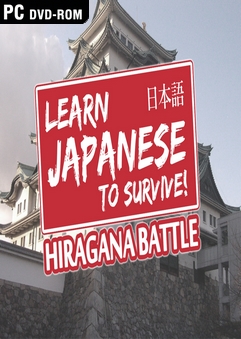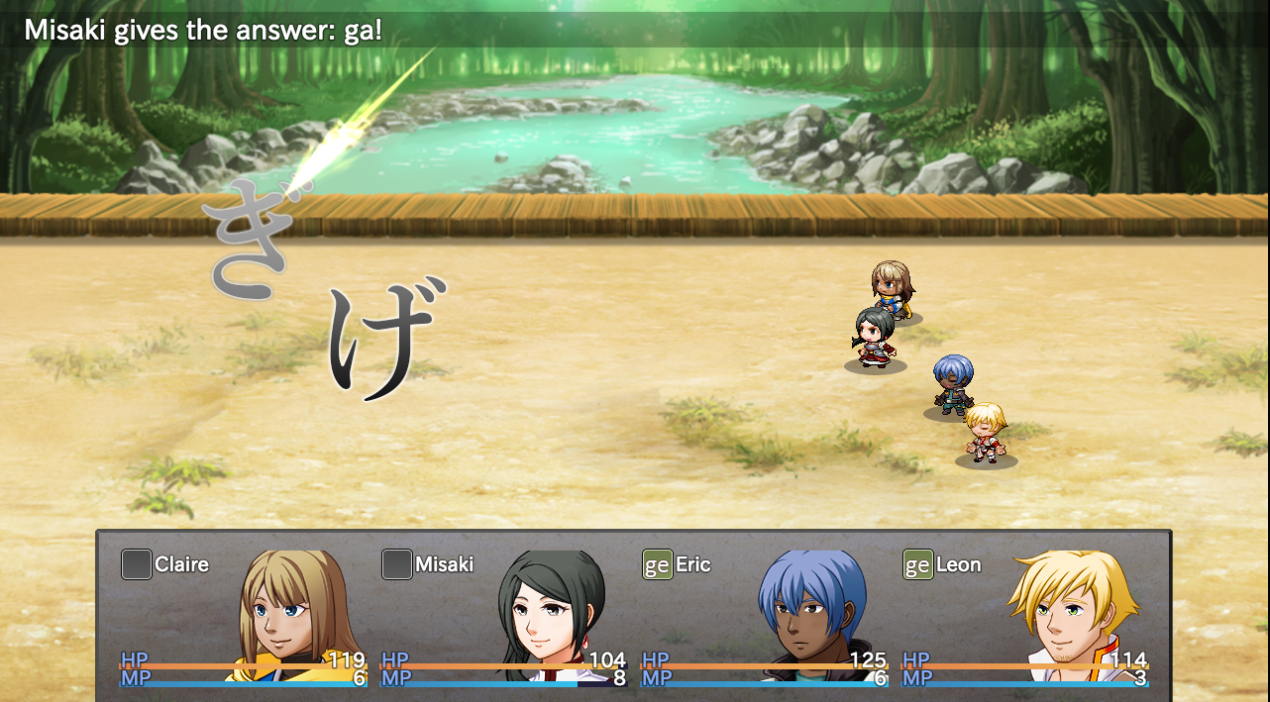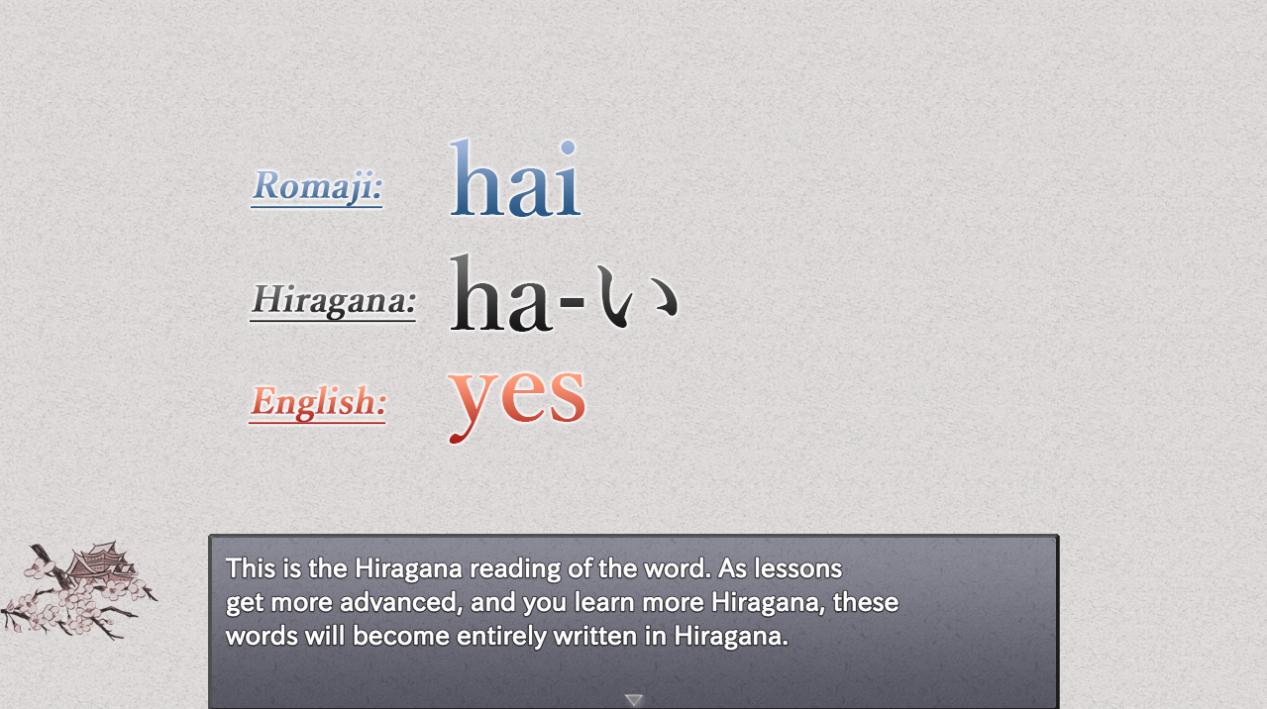Search
[{{{type}}}] {{{reason}}}
{{/data.error.root_cause}}{{{_source.title}}} {{#_source.showPrice}} {{{_source.displayPrice}}} {{/_source.showPrice}}
{{#_source.showLink}} {{/_source.showLink}} {{#_source.showDate}}{{{_source.displayDate}}}
{{/_source.showDate}}{{{_source.description}}}
{{#_source.additionalInfo}}{{#_source.additionalFields}} {{#title}} {{{label}}}: {{{title}}} {{/title}} {{/_source.additionalFields}}
{{/_source.additionalInfo}}- Details
- Category: Computer
- By J. Todd Cumming
- Hits: 6089
Learn Japanese to Survive! Hiragana Battle (Mac)

Learn Japanese to Survive! Hiragana Battle
Developed by: Sleepy Duck Educational Games
Published by: Sleepy Duck Educational Games
Released: February 16, 2016
Available on: Windows, Mac
Genre: RPG, Edutainment
Number of players: 1
Price: $6.99 (digital download, Steam); $19.99 (disc, from developer's Web site)
Claire's village is under attack! A sinister sorcerer has invaded, and his magical army consists of oddly-shaped inky warriors that seem impervious to any known weapon! Fortunately, a tutor from Japan can help Claire and her friends. The warriors are letters of the Hiragana alphabet. In order to win, Claire and her friends must... Learn Japanese to Survive!
It's a somewhat silly premise, but this is surprisingly effective in its approach. Learn Japanese to Survive! Hiragana Battle is apparently the debut game from Sleepy Duck Educational Games, but the name of the company doesn't even appear on the opening menu of the game. It seems like a game made from the RPG Maker line of game development software, but is one of the more interesting ones I've come across.
As mentioned, you guide Claire and her three friends through the world, navigating the different areas to battle the Hiragana warriors and trying to find a way to free their small island from the sorcerer Noburo's clutches. The game plays out a lot like most other JRPGs – navigation is done through an overhead map and the arrow keys. When a battle takes place – which for the most part are random encounters – the screen changes to a scene where Claire and her friends stand at the right side of the screen, and the enemies are on the left. "Attacks" are chosen from a menu. In order to damage the Hiragana warrior, the player must choose the English equivalent from the list. The player also can choose to use items or spells for other effects, such as healing or combat boosts. There's certainly not a lot new or noteworthy with this approach.

Strong Points: Strong Points: Fun way to learn a new language; familiar interface; cute graphics; nice music
Weak Points: Not a fully immersive language experience
Moral Warnings: Minor alcohol references; cartoon violence
But the familiar interface works, since the main focus of the game is, of course, learning Japanese. In between exploring the different areas are lessons in the Hiragana alphabet, with vocabulary lessons thrown in for good measure. Each area is blocked until the player completes the lesson that precedes it, so in order to complete the game, all the lessons must be learned at least once. There is some element of grinding involved, in order to gain the experience and money to survive the newly-unlocked areas. But this also serves as a review of prior lessons, so it actually works out in the end. It's actually one of the more effective ways – and reasons – I've seen to extend the life of an RPG by having the player go through prior areas repeatedly.
The music and graphics are catchy, and reminiscent of the late SNES-era. As a result, the atmosphere of the game tends to be fun and light-hearted, even if the subject matter can be a bit dark. It's cute to see the chibi-style characters bounce happily after winning a battle.
As more lessons are unlocked, the number of attacks that a player can choose from becomes almost overwhelming. This is perfectly understandable, though – not only is this a new language that the player is learning, it's an entirely different alphabet than the Roman style the Western world is familiar with! During the first lesson, the instructor breaks the fourth wall to implore the player to take physical notes as well. Personally, I found it best to write down the lessons in a notebook, and referred to it often while playing the game. It may be a fun game, but it's also educational, so at times it does feel a bit like schoolwork.

Higher is better
(10/10 is perfect)
Game Score - 82%
Gameplay - 16/20
Graphics - 7/10
Sound - 8/10
Stability - 5/5
Controls - 5/5
Morality Score - 91%
Violence - 7/10
Language - 10/10
Sexual Content - 10/10
Occult/Supernatural - 8.5/10
Cultural/Moral/Ethical - 10/10
As for my own children, my youngest two (ages 6 and 8) quickly became bored with the game. My oldest daughter, 12, tried to follow along, but became overwhelmed with trying to copy the Hiragana letters in her own notebook. I can see how some children (or adults) can use this as a fun way to introduce themselves to the language, though. The game also delves into aspects of Japanese culture, including Japanese greetings, food and drinks. Later portions of the game even take place in an abbreviated copy of Japan.
On the moral front, there is little to be concerned about here. Portions of the game do take place in an "inn" and there are a few alcohol references, but it is ambiguous whether the main characters are actually drinking alcohol. Hiragana warriors – which look like letters of the Hiragana alphabet – disappear when defeated, and the party members simply slump to the ground if they fall in battle. There isn't even any offensive magic to worry about in the game. Some of the player's characters can cast healing spells or other magic to increase defenses or strength, but the source of this magic is never explained, so it's questionable whether it's divine or arcane. Certainly there are no religious references that I came across.
While a great introduction to Japanese, it should be noted that this is no Rosetta Stone. It can be helpful to learning how to read Japanese, and perhaps write it. But despite the pronunciation of the words and letters, the game makes a poor substitute to actual, face-to-face dialogue. If someone wanted to learn how to speak Japanese by playing this game, then they would be disappointed. It's a great introduction to the Japanese language, though.
Also, the developer has started a new project called Learn Japanese to Survive! Katakana War. This doesn't appear to be a sequel to this game, but rather a separate RPG that focuses on a different Japanese alphabet, Katakana. It's a promising start for the company, and an interesting way to learn the basics of a new language. For those that enjoy role-playing games, learning new languages, or Japanese culture, Learn Japanese to Survive! would be a very welcome addition to their game libraries.




